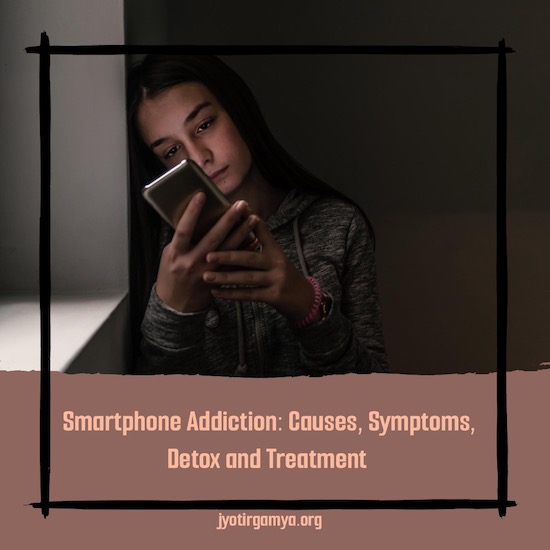Smartphone Addiction: Causes, Symptoms, Detox and Treatment (2023)
From Screens to Nature: A Story of Healing
Once upon a time, a close-knit community of animals thrived in a vibrant and diverse forest. The wise owls shared their sagacity, guiding the younger animals, while energetic rabbits explored the forest’s depths with unbridled curiosity. With their innocence, playful kittens brought joy to every corner of the woodland.

One day, a mysterious stranger, a scientist from a world entangled in advanced technology, arrived. Seeking refuge from the complexities of his realm, he ventured into this forest to grasp the simplicity of the animals' way of life.
Before departing, the stranger bestowed a gift upon the animals: smartphones. He envisioned these devices as tools for learning and growth, yet only if used judiciously.

Initially captivated by the stranger’s devices, the animals immersed themselves in the world beyond the forest, connecting with distant animals. However, the allure of endless entertainment and information gradually led them down a dangerous path of addiction.
The consequences were profound. The wise owls ceased sharing stories with their young, the rabbits abandoned their explorative ventures, and the kittens forsook their playful interactions. The once-social community became withdrawn, grappling with physical and mental health issues like sleep deprivation, eye strain, and anxiety.
Witnessing the havoc wrought by his gift, the stranger was gripped by remorse. He acknowledged underestimating the addictive potential of smartphones and failing to prepare the animals for responsible technology use.
Determined to mend the situation, the stranger chose to stay. Collaborating with the owls, he devised a digital detox plan encompassing the following steps:
- Limit screen time to two hours per day.
- Take breaks from devices every hour.
- Avoid using devices at bedtime.
- Engage in traditional activities, such as storytelling, exploring the forest, and playing games.
Though initially challenging, the animals, supported by each other and the stranger, overcame anxiety and boredom withdrawal symptoms.
Over time, the benefits of the digital detox plan materialized. The animals slept better, felt happier and healthier, and their relationships flourished. The owls nurtured patience and love, the rabbits fostered cooperation over competition, and the kittens reveled in affection and playfulness.
The stranger, delighted to witness the community’s recovery, imbibed profound lessons about responsibility and the intricate relationship between technology and nature. After many months, he decided it was time to return to his world, leaving behind a community on the path to harmony.

Despite their sorrow at his departure, the animals were grateful for his guidance. They pledged to perpetuate the lessons learned and maintain a balanced technological approach.
In the ensuing years, the forest community not only thrived but blossomed. The animals continued using smartphones responsibly, finding innovative ways to meld technology with their traditional lifestyle. They crafted educational apps for their young, developed conservation strategies, and forged connections with animal communities worldwide.
Introduction
Smartphone addiction affects people of all ages, but it is especially prevalent among adolescents and young adults.
Smartphone addiction is a behavioral disorder characterized by excessive use of smartphones, leading to negative consequences in a person’s life.
Smartphone addiction is a growing public health concern, with prevalence rates estimated to be between 2.6% and 61.4% in adolescents and young adults. Smartphone addiction can have a significant negative impact on a person’s life, including their physical and mental health, academic performance, social relationships, and overall well-being.

Causes and Risk Factors of Smartphone Addiction
Understanding the causes and risk factors of smartphone addiction is essential for developing effective prevention and treatment strategies. By identifying the factors that make people more vulnerable to smartphone addiction, we can develop targeted interventions to reduce their risk.
Biological factors
-
Genetics: Research suggests that there may be a genetic component to smartphone addiction. For example, studies have shown that people with certain personality traits, such as high impulsivity are more likely to develop smartphone addiction.
-
Brain chemistry: Smartphone addiction is thought to be driven by several neurobiological mechanisms, including dopamine release and altered brain structure. Dopamine is a neurotransmitter that plays a role in reward and motivation. When people use their smartphones, they experience a release of dopamine, which can lead to a cycle of addiction.
Altered brain structure has also been observed in people with smartphone addiction, including reduced gray matter volume in the prefrontal cortex, the area of the brain responsible for impulse control and decision-making.
Psychological factors
-
Personality traits: Certain personality traits, such as low self-esteem and neuroticism, have been linked to smartphone addiction. People with these traits may be more likely to use smartphones to cope with negative emotions or feel better about themselves.
-
Mental health conditions: People with mental health conditions, such as anxiety and depression, are also more likely to develop smartphone addiction. They may use their smartphones as a way to cope with their symptoms or to escape from reality.
Social and environmental factors
-
Peer pressure: Peer pressure can play a role in smartphone addiction. Adolescents and young adults who see their friends using their smartphones excessively may be likelier to do the same.
-
Parental modeling: Parental modeling can also influence smartphone use in children and adolescents. Parents who use their smartphones excessively may say it is okay.
It is important to note that smartphone addiction is a complex phenomenon with multiple causes. Risk factors can interact with each other to increase a person’s risk of developing smartphone addiction. For example, a person with a genetic predisposition to addiction and a history of childhood trauma may be more likely to develop smartphone addiction than someone without these risk factors.
Signs and Symptoms of Smartphone Addiction
Smartphone addiction is a behavioral disorder characterized by excessive use of smartphones, leading to negative consequences in a person’s life. Signs and symptoms of smartphone addiction can be categorized into behavioral, physical, cognitive, and emotional domains.
Behavioral signs
Behavioral signs of smartphone addiction include:
- Constantly checking one’s phone
- Using one’s phone for long periods
- Neglecting work, school, or relationships to use one’s phone
- Feeling anxious or upset when one cannot use one’s phone
- Hiding one’s phone use from others
Physical signs
Physical signs of smartphone addiction include:
- Sleep problems
- Headaches
- Eye strain
- Neck pain
- Carpal tunnel syndrome
Cognitive and emotional signs
Cognitive and emotional signs of smartphone addiction include:
- Difficulty concentrating
- Poor memory
- Impulsivity
- Irritability
- Anxiety
- Depression
Implications
The presence of signs and symptoms of smartphone addiction should prompt further evaluation by a healthcare professional to rule out other medical or psychiatric conditions and to develop a treatment plan that is tailored to the individual’s needs.
Impact of Smartphone Addiction on Different Age Groups
Smartphone addiction can have a significant impact on people of all ages, but it is especially concerning among adolescents and young adults. This is because the brain is still developing during these years, and smartphone addiction can interfere with normal brain development.
Smartphone addiction symptoms in adults
Adult symptoms of smartphone addiction are similar to those in adolescents and young adults, but there may be some key differences. For example, adults may be more likely to use their smartphones for work or professional purposes, and they may be more aware of the negative consequences of their smartphone use. However, adults can still experience significant problems due to smartphone addiction, such as decreased productivity at work, strained relationships, and mental health problems.
Indicators of Teenage Smartphone Abuse
Common indicators of teenage smartphone abuse include:
- Spending excessive amounts of time on the phone (more than two hours per day)
- Neglecting schoolwork, hobbies, and social activities to use the phone
- Hiding phone use from parents or other trusted adults
- Experiencing withdrawal symptoms when unable to use the phone
- Feeling irritable, anxious, or depressed when not using the phone
Consequences of Smartphone Addiction
Smartphone addiction can have many negative consequences on a person’s mental and physical health, financial well-being, and relationships.
Effects on mental health
Smartphone addiction can lead to some mental health problems, including:
- Anxiety: People with smartphone addiction are more likely to experience anxiety, both in general and about their smartphone use.
- Depression: Smartphone addiction has been linked to increased rates of depression.
- Insomnia: People with smartphone addiction may have difficulty falling asleep and staying asleep due to the blue light emitted from smartphones and the stimulating content that people consume on their phones.
- Loneliness: Smartphone addiction can lead to social isolation and loneliness, as people spend more time on their phones and less time interacting with others face-to-face.
Effects on physical health
Smartphone addiction can also have several negative consequences on a person’s physical health, including:
- Sleep problems: As mentioned above, smartphone addiction can lead to insomnia. This can have several negative consequences on physical health, including fatigue, difficulty concentrating, and impaired immune function.
- Eye strain: Spending too much time looking at a smartphone screen can lead to eye strain, headaches, and blurred vision.
- Neck pain: Poor posture is often associated with smartphone use, leading to neck pain and other musculoskeletal problems.
- Weight gain: Smartphone addiction can lead to weight gain due to reduced physical activity and increased snacking while using the phone.
Impact on financial well-being
Smartphone addiction can also hurt a person’s financial well-being. People with smartphone addiction may spend more money on apps, games, and other in-app purchases. They may also be more likely to make impulse purchases online. Additionally, smartphone addiction can lead to lost productivity at work, which can hurt a person’s earnings.
Impact on relationships
Smartphone addiction can also hurt relationships. Smartphone addicts may spend less time and attention on their partners, family, and friends. This can lead to conflict and resentment. Additionally, smartphone addiction can make it difficult for people to connect with others on a deeper level.
Management and Treatment of Smartphone Addiction
Smartphone addiction is a growing public health concern, and there is a growing body of research on its management and treatment. Effective management of smartphone addiction often involves a combination of strategies, including establishing healthier screen time habits, utilizing smartphone addiction apps and websites, and engaging in therapy.
Establishing healthier screen time habits
One of the most critical steps in managing smartphone addiction is establishing healthier screen time habits. This may involve setting limits on how much time each day is spent on the phone, identifying and avoiding triggers for excessive phone use, and engaging in other more rewarding and fulfilling activities than using the phone.
Utilizing smartphone addiction apps and websites for management
There are many smartphone addiction apps and websites that can help manage phone use. These apps and websites can provide users with insights into their phone usage patterns, help them set limits on screen time, and block access to certain apps and websites.
Different types of therapy for treating smartphone addiction
Several different types of therapy can be effective in treating smartphone addiction. One common type of therapy is cognitive-behavioral therapy (CBT). CBT helps people to identify and change the thoughts and behaviors that contribute to their addiction. Another type of therapy that is sometimes used to treat smartphone addiction is exposure and response prevention (ERP). ERP involves gradually exposing people to the triggers for excessive phone use and helping them develop coping skills to resist the urge to use their phones.
Prevention of Smartphone Addiction
Tips for Parents
- Set clear and consistent limits on screen time.
- Model healthy smartphone use for your children.
- Talk to your children about the potential negative consequences of excessive smartphone use, such as sleep, relationship, and academic problems.
- Encourage your children to engage in other activities, such as playing outside, spending time with friends and family, and pursuing hobbies.
- Use parental controls to monitor your children’s smartphone use and block access to inappropriate content.
Tips for Adults
- Set limits on your own screen time.
- Identify and avoid triggers for excessive smartphone use.
- Delete unnecessary apps from your phone.
- Turn off notifications for all but the most essential apps.
- Keep your phone out of your bedroom at night.
- Find other activities instead of phone use, such as reading, exercising, or spending time with loved ones.
By following these tips, parents and adults can help prevent smartphone addiction in themselves and their children.
Digital Detox Strategies for Mental and Physical Well-Being
Digital detox is the voluntary abstinence from electronic devices, such as smartphones, computers, and televisions, for some time. It has become increasingly important in our digital world, as excessive technology use can lead to several negative consequences, including stress, sleep problems, and social isolation. Digital detox can offer several benefits for both mental and physical well-being, including:
- Reduced stress
- Improved sleep quality
- Increased social interaction
- Enhanced focus and concentration
- Improved mood and overall well-being
Strategies for Digital Detox
There are several strategies that individuals can use to unplug from technology and implement a digital detox. Some helpful tips include:
- Setting aside specific times each day to be technology-free, such as during meals, before bed, or for a few hours each weekend
- Turning off notifications for all but the most important apps
- Deleting unnecessary apps from the phone
- Leaving the phone in another room when trying to focus or relax
- Engaging in other activities instead of using smartphones, such as spending time with loved ones, getting outside, pursuing hobbies, reading, or exercising
- Creating a technology-free zone in the home by designating one room as such, creating a charging station for all electronic devices, setting rules for technology use, and modeling healthy smartphone habits for children
Conclusion
Smartphone addiction is a severe problem that can have a significant impact on a person’s mental and physical health, academic performance, relationships, and overall well-being.
Symptoms of smartphone addiction include difficulty controlling smartphone use, preoccupation with smartphone use, giving increased priority to smartphone use over other activities, increased tolerance, withdrawal symptoms when smartphone use is reduced or discontinued, and negative consequences related to smartphone use.
If you are concerned that you or someone you know may have a smartphone addiction, there are several steps you can take. First, take a smartphone addiction assessment online to see if you meet the criteria for the disorder. If you do, download a smartphone usage tracking app to monitor your usage and identify patterns. You may also want to seek professional help from a therapist or counselor who can help you develop a plan to reduce your smartphone use and manage your addiction.
Here are some tips for maintaining a healthy relationship with technology:
- Set limits on screen time and stick to them.
- Take breaks from technology throughout the day.
- Create technology-free zones in your home and workplace.
- Engage in other activities besides using technology.
- Be mindful of how technology impacts your mood, thoughts, and behaviors.
Following these tips can reduce your risk of developing smartphone addiction and maintain a healthy relationship with technology.
Further Reading
-
Emotional Well-Being through Brain Waves: Managing Stress and Emotions
-
Understanding the Differences Between Neurosis and Psychosis
-
The Ultimate Guide to Remote Work Burnout : 10X Bee vs 0.1X Butterfly
-
The 10X Rule Unveiled: Exploring Grant Cordone’s Approach to Success and Evidence-Based Alternatives
Want to stay connected? Here’s our twitter.